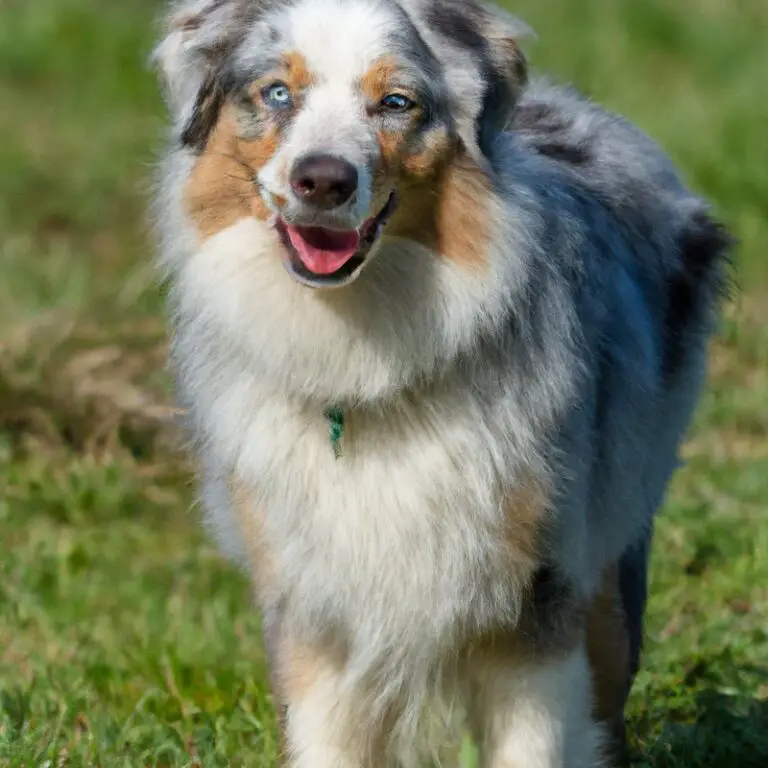Can Australian Shepherds Be Trained To Do Therapy Work With The Elderly?
Key Takeaways:
- Australian Shepherds can be trained successfully to do therapy work with the elderly.
- Therapy-trained Australian Shepherds can provide emotional support and companionship to elderly individuals.
- The temperament and intelligence of Australian Shepherds make them well-suited for therapy work.
- Proper training and socialization are crucial for Australian Shepherds to excel in therapy work with the elderly.
Are you looking for a furry companion who can bring joy and comfort into the lives of the elderly? Well, look no further because Australian Shepherds might just be the perfect fit! These intelligent, friendly, and versatile dogs have a natural ability to connect with people, making them an excellent choice for therapy work with the elderly.
As an expert on this topic, I can assure you that therapy work for dogs can have incredible benefits for both the animals and the humans they interact with.
Let’s dive in and explore the characteristics of Australian Shepherds, the training requirements, and the steps to successfully train them for therapy work. Get ready to be amazed by the incredible bond they can create and the positive impact they can have on the lives of the elderly!
| Question | Answer |
| Topic | Can Australian Shepherds be trained to do therapy work with the elderly? |
| Background | Australian Shepherds are an intelligent and versatile breed known for their herding abilities. They are often used as working dogs in various fields, including therapy work. |
| Pros |
|
| Cons |
|
| Conclusion | Australian Shepherds have the potential to be trained for therapy work with the elderly, but it is important to consider the individual dog’s temperament and suitability for this type of work. Proper training and socialization are essential to ensure the dog can safely and effectively interact with elderly individuals. |
What is therapy work for dogs?
Definition of therapy work for dogs
Therapy work for dogs refers to the practice of using dogs to provide emotional support and assistance to individuals in need. This type of work involves trained dogs visiting various settings, such as hospitals, nursing homes, and rehabilitation centers, to interact with people and improve their wellbeing.
Therapy dogs are not the same as service dogs or emotional support animals.
While service dogs are trained to perform specific tasks to help individuals with disabilities, therapy dogs are trained to engage with people in a therapeutic context. They provide comfort, reduce anxiety, and promote emotional healing through their presence and interactions.
The goal of therapy work is to enhance the quality of life for those in need, including the elderly, hospitalized individuals, children with disabilities, and individuals experiencing mental health challenges.
These dogs are carefully selected, trained, and evaluated to ensure they have the right temperament, obedience skills, and ability to handle different environments and people. Therapy work for dogs can involve various activities, such as offering gentle physical contact, listening attentively, performing tricks or obedience commands, and simply providing companionship.
The presence of a therapy dog can have numerous benefits, including reducing stress, lowering blood pressure, increasing social interactions, and improving overall emotional well-being.
It’s important to note that therapy dogs are not personal pets and are typically owned and handled by their trainers or designated handlers. The training process for therapy work requires a significant time commitment and dedication from both the dog and handler.
It involves basic obedience training, specialized therapy training, and ongoing practice and evaluation to ensure the dog’s suitability for therapy work.
Overall, therapy work for dogs plays a vital role in improving the lives of individuals in need. It provides a source of comfort, companionship, and emotional support, making a positive impact on the well-being of both humans and dogs alike.
Benefits of therapy work for dogs and humans
Therapy work for dogs can benefit both the dogs themselves and the humans they interact with. Let’s talk about the benefits for both parties.
For dogs, therapy work provides mental and physical stimulation.
It gives them a purpose and a sense of fulfillment. Engaging in therapy work can also improve their social skills and overall behavior.
It helps them build confidence and trust in new situations and environments.
Humans, on the other hand, experience emotional and physiological benefits from interacting with therapy dogs. Spending time with these furry companions has been shown to reduce stress, anxiety, and even blood pressure.
Interacting with dogs can also boost mood, improve social interaction, and provide a sense of comfort and companionship.
Therapy dogs have a unique ability to provide unconditional love, support, and a sense of calmness to those in need. They can bring smiles to the faces of the elderly, comfort children in hospitals, and provide a source of emotional support for individuals with mental health conditions.
The presence of therapy dogs can also create a positive and welcoming atmosphere in various settings, such as schools, nursing homes, and hospitals.

Characteristics of Australian Shepherds
History and origin of Australian Shepherds
The Australian Shepherd is a herding dog that originated in the United States, despite its name. Despite being called “Australian,” this breed actually has no known connection to Australia.
The breed’s ancestors were thought to have arrived in the United States during the 19th century through various routes, including Spanish and Basque sheepdogs.
These dogs were highly valued for their herding abilities and were often used to manage livestock on ranches and farms. The breed’s intelligence, agility, and stamina made them well-suited for the demanding tasks of herding cattle and sheep.
The exact origins of the Australian Shepherd are still a subject of debate among experts.
However, it is widely believed that they were developed by crossing various herding breeds, including the Border Collie and the Australian Collie, which may be responsible for the breed’s name confusion. Over time, Australian Shepherds gained popularity not only as working dogs but also as beloved companions and show dogs.
They became recognized by the American Kennel Club (AKC) in the 1990s and are now treasured for their loyalty, versatility, and trainability.
Today, Australian Shepherds are actively involved in various dog sports and activities, including obedience trials, agility competitions, and therapy work. Despite their rich history and strong herding instincts, they have successfully transitioned into fulfilling roles beyond the herding field.

Physical and temperament traits of Australian Shepherds
Australian Shepherds are known for their distinct physical and temperament traits. Physically, they are medium-sized dogs with a well-balanced and athletic build.
They have a double coat, which is weather-resistant and can be of various colors and patterns.
Their eyes are typically brown or blue, and they have a strong, muscular body. In terms of temperament, Australian Shepherds are highly intelligent, energetic, and eager to please.
They have a strong work drive and are known for their herding instincts.
They are often described as being alert, loyal, and protective of their families. They are also social dogs and tend to get along well with children and other pets.
However, it’s worth noting that Australian Shepherds can be high-energy and may require plenty of exercise and mental stimulation.
They thrive in an environment that allows them to engage in activities such as obedience training, agility, or herding trials. Without proper exercise and mental stimulation, they may exhibit destructive behavior or become anxious.
When considering Australian Shepherds for therapy work, their physical and temperament traits can be advantageous.
Their intelligence and trainability allow them to quickly learn and adapt to various tasks and commands. Their energy and enthusiasm can bring joy and comfort to the elderly.
However, their high energy levels may also require additional attention and management during therapy sessions.
Overall, Australian Shepherds possess physical and temperament traits that make them well-suited for therapy work. With proper training, socialization, and adequate exercise, they can excel in providing comfort, companionship, and emotional support to the elderly.

Training requirements for therapy work
Basic obedience training for Australian Shepherds
Basic obedience training is essential for Australian Shepherds, especially if you want them to excel in therapy work. To train them effectively, I recommend using positive reinforcement techniques such as rewards and praise.
Start with basic commands like sit, stay, come, and heel.
Consistency is key, so practice the commands regularly and in different environments. Australian Shepherds are intelligent and eager to please, so training them should be a rewarding experience for both of you.
Remember to be patient, stay consistent, and have fun while training your Australian Shepherd in basic obedience.
Specialized training for therapy work
Specialized training for therapy work involves equipping Australian Shepherds with the necessary skills and behaviors to engage in therapy work with the elderly. This type of training focuses on teaching the dog to be calm, gentle, and well-mannered in various situations.
One crucial aspect of specialized training is teaching the dog to be comfortable around wheelchairs, walkers, and other mobility aids commonly used by elderly individuals.
This helps ensure that the dog can navigate around these devices without causing any disruptions or fear. Additionally, therapy dogs must be trained to walk on a loose leash and have good impulse control.
This allows them to move calmly and freely while interacting with the elderly, without pulling or tugging on the leash.
Another important aspect of specialized training is teaching the dog to tolerate being touched and handled in a gentle manner. This is especially important when working with individuals who may have limited mobility or sensitivity to touch.
Furthermore, therapy dogs should be trained to perform specific tasks that can provide comfort and companionship to the elderly.
For example, they may be trained to offer a paw to hold, to lie on a person’s lap, or to retrieve an object. Overall, specialized training for therapy work involves teaching Australian Shepherds to be well-behaved, calm, and responsive in various caregiving situations.
This training enables them to provide emotional support and companionship to the elderly, making a positive impact in their lives.
Australian Shepherds in therapy work
Challenges and limitations of Australian Shepherds in therapy work
Challenges and limitations can arise when using Australian Shepherds in therapy work. While they have many positive qualities, there are a few factors to consider.
Firstly, Australian Shepherds have high energy levels and need regular exercise to stay happy and focused.
This can be challenging in therapy settings where calm behavior is required. Additionally, their herding instincts may cause them to try to control or corral the people they are working with, which can be overwhelming for some individuals.
Another limitation is that Australian Shepherds may be sensitive to loud noises or sudden movements, which could make certain therapy environments difficult for them to navigate.
Despite these challenges, with proper training, socialization, and ongoing support, Australian Shepherds can still excel in therapy work. It’s important to work closely with a reputable trainer or organization to address these challenges and monitor the well-being of the dog during therapy sessions.
Steps to train Australian Shepherds for therapy work
Finding a reputable trainer or organization
When it comes to training your Australian Shepherd for therapy work, finding a reputable trainer or organization is crucial. Look for trainers who specialize in therapy dog training or have experience with Australian Shepherds.
Consider recommendations from other dog owners who have successfully trained their dogs for therapy work.
Research local therapy dog organizations and ask for their recommendations as well. It’s important to choose a trainer or organization that uses positive reinforcement methods and focuses on building a strong bond between you and your dog.
By finding the right trainer or organization, you’ll be on your way to successfully training your Australian Shepherd for therapy work.
Socializing and exposing Australian Shepherds to different environments
Socializing and exposing Australian Shepherds to different environments plays a key role in their training for therapy work. It helps them become comfortable and confident in various settings, which is essential for their interactions with elderly individuals.
One way to socialize Australian Shepherds is by introducing them to different people, including individuals of different ages, genders, and ethnicities.
This exposure helps them become more friendly and adaptable in their interactions. It is also important to expose them to different environments such as parks, shopping centers, and busy streets.
This helps them become accustomed to different sounds, sights, and smells, reducing any anxiety or fear they may experience during therapy work.
Additionally, exposing them to other animals, such as dogs, cats, or small animals, can help them develop appropriate social behaviors. It teaches them how to interact with other animals calmly and respectfully.
Regular visits to nursing homes or retirement communities can further enhance their socialization skills.
It allows them to encounter and interact with a diverse group of elderly individuals, preparing them for therapy work with seniors. By gradually exposing them to new environments and experiences, Australian Shepherds will become well-rounded and socialized, making them ideal candidates for therapy work with the elderly.
Gradual introduction to therapy work tasks and scenarios
When training Australian Shepherds for therapy work, gradually introducing them to different tasks and scenarios is important. Start by exposing them to calm and controlled environments, allowing them to observe and familiarize themselves with the surroundings.
Then, slowly introduce them to new stimuli, such as different sounds, smells, and sights.
This can be done through supervised visits to hospitals, nursing homes, or other therapy settings. As they become more comfortable, gradually increase the complexity of tasks, such as interacting with people or performing specific actions.
This gradual approach helps them build confidence and adapt to the demands of therapy work.
Tips for a successful therapy work experience
Building a bond and trust with the dog
Building a bond and trust with your dog is essential for successful therapy work. To do so, spend quality time with your Australian Shepherd, engaging in activities that they enjoy.
Regular training sessions and playtime help create a strong connection.
Be patient and consistent in your interactions, using positive reinforcement to strengthen the bond. Allow your dog to feel safe and supported, and listen attentively to their needs.
Trust takes time to develop, so be understanding and nurturing.
Remember, a strong bond is the foundation for a successful therapy work experience with your Australian Shepherd.
Monitoring the dog’s stress levels and well-being
When it comes to therapy work with Australian Shepherds, it’s crucial to always monitor their stress levels and overall well-being. Dogs, like humans, can experience stress in different situations, so it’s important to pay attention to their behavior and body language.
One way to monitor your dog’s stress levels is to observe their behavior during therapy sessions.
Look for signs of stress such as panting, restlessness, or excessive yawning. If you notice any of these signs, it may be a sign that your dog is feeling overwhelmed and needs a break.
Another important aspect of monitoring your dog’s well-being is to regularly check their physical health.
Make sure your dog is getting regular check-ups with the veterinarian to ensure they are in good health and not experiencing any underlying medical issues that could impact their ability to do therapy work. Additionally, providing your Australian Shepherd with a comfortable and safe environment is essential.
This means ensuring they have a quiet space to rest and relax, away from any potential stressors.
Also, make sure they have access to fresh water, proper nutrition, and enough exercise to keep them physically and mentally stimulated. Regularly assessing your dog’s stress levels and overall well-being is crucial for a successful therapy work experience.
By paying close attention to their behavior, physical health, and providing them with a safe and comfortable environment, you can ensure that your Australian Shepherd is happy and healthy while doing therapy work with the elderly.
Maintaining regular training and refreshers
Maintaining regular training and refreshers is essential for a successful therapy work experience with Australian Shepherds. Regular training sessions help reinforce learned behaviors and keep the dog’s skills sharp.
It is important to establish a consistent training schedule and allocate dedicated time for practice.
Additionally, incorporating refreshers into the training routine helps prevent regression and ensures that the dog remains proficient in their therapy tasks. This can include revisiting previously learned commands, practicing obedience exercises, and exposing the dog to various therapy work scenarios.
By consistently training and offering refreshers, you can ensure that your Australian Shepherd is prepared and confident in their therapy work endeavors.
Final Verdict
Australian Shepherds have the potential to excel in therapy work with the elderly. Their intelligent, adaptable, and empathetic nature makes them well-suited for this role.
However, it is important to consider the individual needs and limitations of each dog, as well as the challenges and limitations that Australian Shepherds may face in therapy work.
With proper training, socialization, and ongoing support, Australian Shepherds can become valuable companions for the elderly, bringing joy, comfort, and companionship to those in need. Trustworthy sources and experienced trainers should be sought to ensure the best outcome for both the dog and the elderly individuals they serve.







